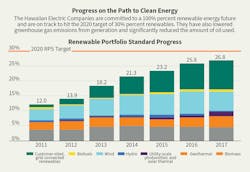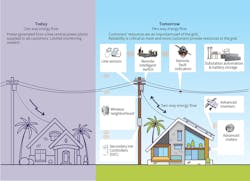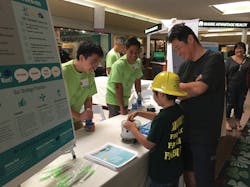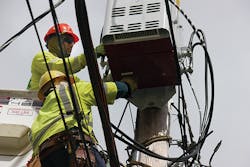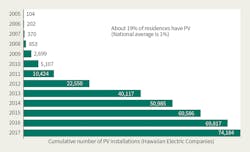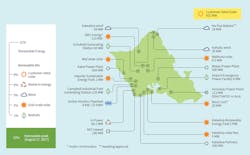The Hawaiian Electric Companies—Hawaiian Electric Co. Inc. and its sister utilities Maui Electric and Hawaii Electric Light—supply electricity to the islands of Oahu, Hawaii, Maui, Lānai and Molokai using a transmission system and distribution network originally designed to deliver electrical energy in one direction, from several large power plants to all customers. The utilities are now working together to improve the two-way flow of energy that has evolved from customer-sited generation.
Across the three utilities’ service territories, some 80,000 privately owned rooftop solar power systems can export energy to the distribution network to supply other customers. This two-way flow of energy requires a flexible, responsive distribution network to accommodate these thousands of neighborhood virtual power plants. To meet this challenge, the utilities developed a comprehensive strategy to transform the power delivery network, so it will be ready and resilient for the interconnection of an increasing volume of renewable energy sources.
In August 2017, the Hawaiian Electric Companies submitted a plan, called “Modernizing Hawaii’s Grid for Our Customers,” to the Hawaii Public Utilities Commission (PUC). The plan described how a comprehensive grid modernization strategy was essential to reaching the state’s goal of transitioning to 100% renewable resources for power generation by 2045. Regulators approved implementation of the first phase of the plan in February 2018.
Developing the Strategy
The grid modernization strategy was the result of extensive customer outreach, technology research and piloting of the latest technologies, with the goal of providing customer choice, equity and cost savings in addition to greater access to distributed energy resources (DER). The Hawaiian Electric Companies have become leaders in finding cost-effective alternatives to infrastructure upgrades that will help to encourage and integrate more customer-sited solar power.
Rapidly evolving technologies in storage, voltage management tools and advanced inverters will help to more than triple the amount of private rooftop solar power in Hawaii. Customers will have new options such as flexible demand response and electric vehicle charging programs that also will provide the grid services necessary to ensure grid stability. In addition, new technology will improve the reliability and resilience of the islands’ electric systems, which are threatened by the growing impacts of climate change.
Many of the technologies incorporated in the Hawaiian Electric Companies’ strategy are the result of Hawaiian Electric pilot projects and studies. For example, to address voltage fluctuations caused by sudden changes in solar power generation and identify ways to integrate more DER, the utilities have developed a non-wires voltage management and optimization strategy.
Following extensive research and collaboration with the National Renewable Energy Laboratory (NREL), the utilities will rely on private rooftop solar to manage voltage through autonomous advanced inverter functionality. Then, grid-edge devices such as secondary volt-ampere-reactive (VAR) controllers will be used to supplement the advanced inverter functions.
Voltage Management
The Hawaiian Electric Companies worked with NREL to improve the way in which the grid operates with high levels of distributed solar, largely by changing the way the inverters operate. The collaborative study, “Simulation of Hawaiian Electric Companies Feeder Operations with Advanced Inverters and Analysis of Annual Photovoltaic Energy Curtailment,” includes recommendations for the activation of voltage regulation grid-support functions (GSF) to enable the utilities’ grid planners to interconnect more customer-sited rooftop solar.
Recommendations include the combined activation of volt-VAR (reactive power priority) with volt-watt and the deactivation of fixed power factor. The activation of volt-VAR and volt-watt resulted in the interconnection of more solar and the least energy curtailment when compared with other combinations of GSF, like the activation of fixed power factor. With the combined activation of volt-VAR and volt-watt, the Hawaiian Electric Companies will be able to provide a non-wires alternative for customers who experience secondary high-voltage issues to interconnect their photovoltaic (PV) systems safely.
However, advanced inverter functions alone may not solve the growing hosting capacity issues. Grid-edge technologies, such as dynamic VAR controllers (DVCs) also will play a major role in enabling greater private rooftop solar adoption. The utilities launched a pilot project with Varentec Inc., which deployed DVCs on distribution circuits in Kailua, a suburb of Honolulu, Hawaii, U.S., with high penetrations of solar. The first phase of the pilot study, which ended in 2017, demonstrated DVCs achieve a fast and dynamic response to load and solar generation changes, ensuring service voltages are kept within industry standards.
More importantly, the study concluded that deployment of secondary VAR controllers will increase the medium-voltage (MV) feeder’s solar hosting capacity from 5 MW to 7 MW, providing a 40% increase in hosting capacity. For saturated circuits, use of DVCs will increase the adoption of private rooftop solar, which might not occur if customers had to pay for costly infrastructure upgrades.
Conservation Voltage Regulation
In devising their grid modernization strategy, the Hawaiian Electric Companies have had to overcome unique technical challenges that required outside-the-box solutions. For instance, Varentec’s DVC traditionally has been used for conservation voltage reduction for energy savings or peak demand reduction. However, the utilities faced a different problem: voltage fluctuations attributable to the large number of DER on the distribution systems. The Hawaiian Electric Companies recognized a potential for the Varentec DVC to be used in a different configuration to enable even more customer-sited resources to be connected and sought Varentec’s advice on whether the methodology could be varied to meet the utilities’ needs.
In collaboration with Varentec, Hawaiian Electric worked through this challenge to change the use of the device by employing different methodologies and test procedures to enable an additional 2 MW of DER on an already saturated distribution circuit. In an expansion of the pilot project, Hawaiian Electric deployed 100 DVCs and its grid edge management system (GEMS) platform at three Oahu substations with high penetrations of solar. Because of this pilot project, Hawaiian Electric validated the capability of Varentec’s DVC to increase the solar hosting capacity from 1 MW to 3 MW on one of the substations and from 10.34 MW to 14.3 MW on a second substation.
First Phase
An implementation plan for the first phase of the strategy, “Modernizing Hawaii’s Grid for our Customers,” was filed in June 2018. This first phase will include the installation of the following new technologies:
- Deployment of advanced meters on an as-needed and where-needed basis, primarily for enhanced sensing and reliability purposes. This will also enable customers to take advantage of new private rooftop solar programs and variable rates. Customers who participate in new programs that provide grid services also will be able to benefit from these enhanced meter features.
- Launch of a meter data management system, which collects and stores the data received from the advanced meters, will include an online energy portal that enables users to monitor and manage their energy usage.
- Implementation of an interoperable telecommunications network will enable the communication path for both advanced meters and field devices for distribution sensing, control and automation. Currently, programs only rely on cellular services, which are not available in all areas.
The as-needed, or aptly termed walk-jog-run, approach will help to mitigate technology risks and enable the utilities to take advantage of technological advancements as newer technology is deployed. The success of this approach will depend on industry collaboration. For example, the utilities are looking to deploy a telecommunications network that uses open and interoperable standards so future technologies can plug and play. The utilities already have identified the Wi-SUN Alliance standard as a critical piece to their strategy and are actively working with equipment manufacturers to ensure technologies deployed today can evolve as the Wi-SUN standard matures.
The estimated cost for the first phase, which will start in 2019 and continue to 2023, is US$86.3 million, with most customers paying less than $1 a month for the high-tech upgrades. Future phases of the implementation will include an advanced distribution management system (ADMS) and additional field device technology to enable enhanced grid control, visibility and data aggregation functionalities at the edge of the grid.
The Hawaiian Electric Companies’ next application to the PUC will build on the components and technologies introduced in the first phase. The telecommunications network deployed as part of the initial phase will deliver the communications platform necessary for future field devices and advanced meters to provide grid-sensing capabilities and data to the ADMS.
Future Integration
In coordination with grid modernization efforts, asset management will consider future integration so cost-effective technologies and functionalities are embedded in the infrastructure replacements already being deployed. The analogy the Hawaiian Electric Companies use is to avoid paving the road twice—and not having to dig up a freshly paved street to replace underground cables/ducts. This coordination between grid modernization and asset management is a framework to ensure the road to a modern grid only needs to be paved once and modern grid investments are planned, targeted and coordinated.
From its conception, the Hawaiian Electric Companies’ grid modernization strategy has focused heavily on stakeholder and customer engagement. This level of involvement is the new norm for Hawaiian Electric Companies, which are now involving more stakeholders in the planning process.
Recognizing that planning based on modeling theoretical values will no longer work—because of the scale of resource diversity and complexity in Hawaii—the utilities have embarked on a new integrated grid-planning system. Therefore, it is essential to integrate market-based solutions and related integration considerations into the planning analysis to evaluate the best resource and grid options for customers. This process aims to serve as the framework, among other things, to set the evolving strategy of grid modernization investments for the longer term in a cost-effective manner.
The Hawaiian Electric Companies also propose to leap ahead to an innovative systems approach to energy planning. This fully integrated planning process aims to yield the most cost-effective renewable energy pathways, rooted in customer and stakeholder input.
Also, by streamlining traditionally disparate and serial tasks related to planning and procurement into a unified process, what currently takes up to three years to complete is expected to be reduced to 18 months. Moreover, Hawaii will benefit from expanded market opportunities for resources, grid services and non-wires alternatives for T&D, which can foster innovative solutions for a new energy economy.
Rodney Chong ([email protected]) is director of grid modernization at Hawaiian Electric Co. Inc. and provides leadership and strategic direction on matters related to the implementation of the Hawaiian Electric Companies’ grid modernization strategy. He joined Hawaiian Electric’s engineering department in 1991 and most recently served as manager of renewable acquisition, a critical role that required working with key energy stakeholders to facilitate the utilities’ progress toward meeting the state’s 100% renewable energy goal.
Marc Asano ([email protected]) is the manager of advanced T&D planning at Hawaiian Electric Co. Inc., leading the development of long-range plans and strategies for the integration of distributed energy resources. He played an instrumental role in developing the Hawaiian Electric Companies’ grid modernization strategy. Asano, who joined Hawaiian Electric in 2007, was a lead distribution planning engineer and led high photovoltaic penetration studies that enabled Hawaiian Electric to integrate greater amounts of rooftop distributed photovoltaic generation.
For more information:
Hawaiian Electric | www.hawaiianelectric.com
Hawaii Electric Light | www.hawaiielectriclight.comdis
Hawaii Public Utilities Commission | http://puc.hawaii.gov
Maui Electric | www.mauielectric.com
NREL | www.nrel.gov
Varentec | http://varentec.com
Wi-SUN | www.wi-sun.org
About the Author
Rodney Chong
Director of grid modernization
Rodney Chong is director of grid modernization at Hawaiian Electric Co. Inc. and provides leadership and strategic direction on matters related to the implementation of the Hawaiian Electric Companies’ grid modernization strategy. He joined Hawaiian Electric’s engineering department in 1991 and most recently served as manager of renewable acquisition, a critical role that required working with key energy stakeholders to facilitate the utilities’ progress toward meeting the state’s 100% renewable energy goal.
Marc Asano
Marc Asano is the Director of Integrated Grid Planning with over 17 years of utility experience. He has led Hawaiian Electric’s development of long-range plans and strategies to achieve 100% renewable energy, including significant quantities of distributed energy resources, its grid modernization strategy and most recently its Wildfire Safety Strategy.

